下载中心
优秀审稿专家
优秀论文
相关链接
摘要

本文研究最冷目标地物替代法计算Jason-2微波辐射计JMR年度漂移。针对Jason-2卫星微波辐射计(JMR),利用微波辐射计传输模型,建立JMR 3个通道的全球最低亮温观测值的理论计算模型,模拟其3通道全球地物观测最冷亮温;基于2008年—2012年Jason-2地球物理数据(GDR)产品中全球对地观测亮温序列和模型计算的最冷亮温,建立亮温序列的最小观测亮温统计模型,查找全球地物观测最冷亮温序列;根据地物年度变化特性,建立光谱分析模型,去除最冷亮温序列的年度谐波;去除年度谐波后,采用线性拟合的方法外推最冷亮温序列的理论最小值,并据此计算Jason-2微波辐射计仪器的年度漂移量。
We study the coldest vicarious calibration method for the Jason-2 Microwave Radiometer (JMR). We simulated the observed value of the global minimum brightness temperature for three JMR channels using the microwave radiation transfer theoretical calculation model. Using 2008 to 2012 Jason-2 geophysical data record data products for global earth observations of brightness temperature, we establish a statistical model for identifying the coldest brightness temperature series. We then set up a spectral analysis model, according to the annual change characteristics, to remove the annual harmonic from the coldest brightness temperature series. Using the linear fitting method, the annual harmonic is removed and then extrapolated to the theoretical minimum brightness temperature, to calculate the annual drift of the JMR instrument.

